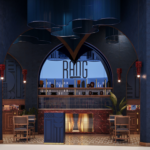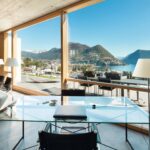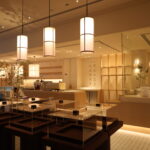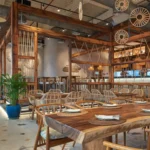Introduction
How to Impress Your Clients ? : Creating an impressive interior fitout is crucial for businesses in the competitive world of interior design and architecture. It’s not just about aesthetics; it’s about wowing your clients with the perfect blend of style and functionality. In this article, we will delve into the art of impressing your clients using the best interior fitout, covering everything from design principles to client communication. So, let’s get started on your journey to becoming a fitout maestro!
What is Interior Fitout?
Interior fitout refers to the meticulous process of designing and furnishing interior spaces to optimize their functionality, aesthetics, and comfort. It involves the careful selection of furniture, fixtures, color schemes, lighting, and spatial arrangements to create harmonious and appealing environments. The primary objective of interior fitout is to transform empty or existing spaces into fully functional, visually pleasing areas that align with the client’s vision and purpose. This meticulous attention to detail ensures that every aspect of the interior is carefully curated, resulting in spaces that not only meet practical needs but also leave a lasting impression through their design and ambiance.
The Role of Interior Fitout
The role of interior fitout is pivotal in the world of design and architecture, encompassing the transformation of empty spaces into functional, aesthetically pleasing environments. It plays a crucial part in setting the stage for the overall ambiance and functionality of a space, focusing on creating visually appealing and ergonomic interiors. Interior fitout balances elements such as color schemes, textures, lighting, and spatial arrangements to achieve harmony. Its emphasis on functionality ensures that spaces are not just beautiful but also practical. By aligning with the client’s vision, interior fitout contributes to creating spaces that leave a lasting impression and meet the needs of occupants.
Establishing Client Rapport
Impressing clients starts with effective communication and rapport-building.
Active Listening
Active listening is a vital communication skill that involves attentive and engaged participation in a conversation. It goes beyond merely hearing words; it entails fully focusing on the speaker, understanding their message, and showing empathy. Active listeners maintain eye contact, provide non-verbal cues of interest, and avoid interrupting. They ask clarifying questions and summarize what they’ve heard to ensure accurate comprehension. This practice fosters trust and deeper connections in personal and professional relationships. Active listening is a major key to how to impress your clients, enabling individuals to better understand others, resolve conflicts, and build rapport by genuinely valuing and respecting the speaker’s perspective.
Clear Communication
Clear communication is the art of conveying ideas, information, or messages in a straightforward and easily understood manner. It involves using concise language, avoiding jargon, and structuring your message logically. Effective communicators consider their audience’s knowledge and perspective, tailoring their communication to be relevant and accessible. Clarity is enhanced through active listening, allowing for two-way communication and the opportunity to address questions or concerns. Clear communication builds trust and minimizes misunderstandings, fostering productive interactions in both personal and professional settings. It is a fundamental skill for effective collaboration, problem-solving, and achieving shared goals.
Creating Stunning Visuals
Visual appeal is a top priority in interior fitout. Here’s how to achieve it:
Balance and Harmony
It is an essential principles that contribute to visually pleasing and well-structured compositions. Balance refers to the distribution of visual elements within a design, ensuring that no single element dominates, creating equilibrium. This can be achieved through symmetry, where elements are mirrored on both sides, or asymmetry, where elements of different visual weight are balanced strategically. Harmony involves the pleasing arrangement of elements, such as color, texture, and shape, to create a sense of unity and cohesion. When balance and harmony are successfully incorporated into design, the result is an aesthetically pleasing and visually satisfying composition that resonates with viewers.
Lighting Magic
Lighting magic is the transformative art of using illumination to create captivating and functional spaces. It goes beyond mere functionality, enhancing the ambiance and mood of an environment. Strategic lighting design involves the selection of fixtures, positioning, and intensity to achieve desired effects. Ambient, task, and accent lighting are key components that work together to create a harmonious balance. Ambient lighting sets the overall tone, task lighting serves practical purposes, and accent lighting highlights specific features or focal points. The interplay of these elements can produce dramatic and enchanting effects, making spaces come alive and evoking emotions, turning any room into a mesmerizing experience.
Functional Design
A beautiful interior is only effective if it’s functional.
Ergonomics
Ergonomics is the science of designing and arranging products, environments, and systems to optimize human well-being and overall performance. It focuses on creating user-friendly and efficient designs that promote comfort, safety, and productivity. Ergonomic principles are applied across various domains, from office furniture and computer setups to vehicle interiors and industrial machinery. Key considerations in ergonomics include aligning workspaces with the natural movements and capabilities of the human body, reducing strain, and minimizing the risk of injuries or discomfort. By prioritizing ergonomics, designers and professionals ensure that their creations are user-centric, enhancing both comfort and efficiency for individuals in various settings.
Space Optimization
Space optimization is the strategic and efficient use of available space to maximize functionality and utility. It involves careful planning and design to ensure that every square foot serves a purpose. This can include smart storage solutions, flexible layouts, and multifunctional furniture. The goal is to make the most of limited space, allowing for ease of movement and a clutter-free environment. In both residential and commercial settings, space optimization enhances comfort and usability. It creates an organized and visually appealing space that not only meets immediate needs but also adapts to changing requirements, making it a practical and valuable approach to design.
Sustainable Choices
Clients are increasingly conscious of sustainability. Show your commitment to eco-friendly design.
Sustainable Materials
In the quest to impress your clients while prioritizing sustainability, incorporating “how to impress your client” with sustainable materials is paramount. Sustainable materials are environmentally friendly choices that minimize the ecological footprint of your projects. These materials are sourced and produced with practices that reduce resource depletion and pollution. By integrating eco-conscious options like reclaimed wood, recycled metal, or low-VOC paints, you not only showcase your commitment to sustainable design but also ensure a healthier and greener living or working environment for your clients. Utilizing such materials not only impresses clients but also aligns with ethical and responsible design practices.
Energy Efficiency
Energy efficiency is the practice of using less energy to achieve the same or improved results. It involves optimizing energy consumption while reducing waste and minimizing environmental impact. In various sectors, from residential homes to commercial buildings and industries, energy efficiency measures can include upgrading insulation, using energy-efficient appliances and lighting, and implementing smart technologies for better energy management. By focusing on energy efficiency, individuals and organizations can lower their energy bills, reduce greenhouse gas emissions, and contribute to a more sustainable future. It not only conserves resources but also impresses clients by showcasing a commitment to both cost-effectiveness and environmental responsibility.
Staying Updated
Interior design trends evolve, and it’s essential to stay in the loop.
Continuous Learning
Continuous learning is the ongoing process of acquiring new knowledge, skills, and expertise throughout one’s life. It is a commitment to personal and professional growth and an acknowledgment that the world is constantly evolving. In today’s fast-paced society, staying current and adaptable is essential. Continuous learning can take various forms, including formal education, workshops, online courses, reading, and most importantly knowing latest trends in the market. Embracing this approach allows individuals to remain competitive in their careers, broaden their horizons, and adapt to new challenges and opportunities. It is a mindset that fosters innovation and personal development, impressing clients and employers by showcasing a dedication to excellence and staying at the forefront of their field.
Frequently Asked Questions (FAQs):
Q: How long does it take to complete an interior fitout project?
A: The duration varies based on the project’s scope and complexity, but a typical project can take anywhere from a few weeks to several months.
Q: What should I do if a client has a limited budget?
A: Creativity is key. Find cost-effective materials and design solutions that align with the budget without compromising quality.
Q: Is it essential to have formal education in interior design?
A: While formal education can be beneficial, practical experience and a keen eye for design are equally important.
Q: How do I deal with challenging clients?
A: Patience and effective communication are essential. Try to understand their concerns and work collaboratively to find solutions.
Q: What’s the significance of a project portfolio?
A: A portfolio showcases your previous work, giving potential clients a glimpse of your style and capabilities.
Q: How can I ensure client satisfaction?
A: Regular updates, transparency, and exceeding expectations are key to ensuring client satisfaction.
Conclusion
Mastering the art of impressing your clients through the best interior fitout involves a multifaceted approach. By understanding the fundamentals, establishing strong client relationships, creating stunning visuals with balance and harmony, focusing on functionality, and promoting sustainability, you can elevate your interior fitout projects to new heights. Staying updated with industry trends and continuously learning is essential for long-term success. Effective communication, active listening, and a commitment to clear and empathetic dialogue are crucial aspects of building trust with clients. Ultimately, by combining these principles, you can consistently exceed client expectations and establish yourself as a trusted expert in the field of interior fitout.






